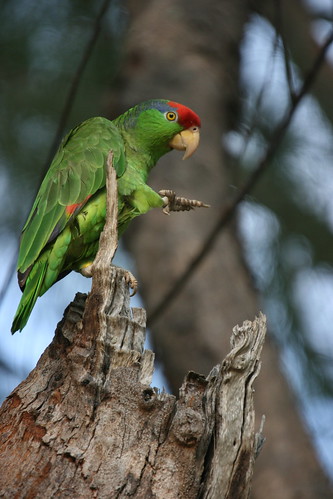 Red-crowned amazon in Palm Beach FLFrom San Francisco to South Florida, populations of nonnative parrots—some imperiled in their tropical homelands—are thriving in U.S. cities and suburbs
Red-crowned amazon in Palm Beach FLFrom San Francisco to South Florida, populations of nonnative parrots—some imperiled in their tropical homelands—are thriving in U.S. cities and suburbs
ON A STEAMY spring morning, Joe Barros and Paul Bithorn of the Tropical Audubon Society were driving around Miami with their windows down, listening for telltale squawks. Winding through golf courses, residential streets and downtown parks, the expert birders were searching for parrots, and they found them all over the city: yellow-chevroned parakeets crowding a backyard feeder, mitred parakeets preening in a melaleuca tree, a colorful flock of Amazons—lilac-crowned, yellow-headed and orange-winged parrots—on power lines, even a pair of blue-and-yellow macaws that flew into a nest in a dead royal palm. In all, Barros and Bithorn spotted 16 species of parrots before sundown, a number that would be difficult for a birder to top anywhere on the planet.
While a quarter of the world’s 352 parrot species are at risk of extinction in their native habitats, populations of introduced parrots in cities like Miami, Chicago, New York and San Francisco appear to be growing. Theses urban areas have become unintended refuges for species—including red-crowned parrots, lilac-crowned parrots and red-masked parakeets—that are at risk in their native habitats due to poaching for the pet trade and habitat loss. Such thriving U.S. populations could play a role in future conservation programs. “Once they get rid of the illegal trafficking of parrots in Mexico, it’s possible that some of the red-crowned parrots in Los Angeles could be reintroduced there,” says ornithologist Bill Pranty, formerly of the Archbold Biological Station in Florida.
All the nonnative parrots are escaped pets or descendants of escapees. Still, it’s not simply careless pet owners or easy pickings from feeders that keep these birds close to people. Parrots are found in the greatest numbers in parts of South Florida and California with large numbers of exotic plants—imported and watered by humans—that produce fruit, seeds and flowers year-round. “That’s one of the reasons you find parrots in the city rather than in Everglades National Park,” says Pranty. Some areas of South Florida may in fact have a greater diversity of parrot species in a smaller area than anywhere else on Earth.
Driving through Miami, Bithorn pointed out another parrot-friendly feature of urban America. Tall, man-made structures such as utility poles and stadium light posts are among the favorite nesting sites of monk parakeets, whose large dome-shaped heaps of interwoven twigs are often found atop electrical transformers. Since their multichambered homes provide protection from icy weather, these South American natives breed as far north as Connecticut, Rhode Island and Illinois and can be found in about a dozen other states. The monk is the only parrot in the world that constructs its own communal nest—rather than nesting in existing cavities—and the birds roost in the nests year-round. This unusual trait has helped the monk become the most widespread—and controversial—parrot in the country.
Twelve inches tall and kiwi green with a pearly gray face and breast, monk parakeets are a beautifully surreal sight on a dark winter day in places like Brooklyn, where they can be seen nesting on lights surrounding Brooklyn College’s soccer field or on the Gothic spires of the entrance gate to Greenwood Cemetery. To many inhabitants of Brooklyn, as well as cities such as New Orleans and Cooper City, Florida, monks are a source of neighborhood pride.
Among others, though, the birds have stirred controversy ever since they began showing up in the wild in the late 1960s. At first, wildlife officials worried the parakeets would damage crops or drive out native birds, fears that have not been realized. But these days the monks’ impact on the nation’s power grid is receiving more attention. Weighing up to several hundred pounds apiece, nests built on electric utility structures occasionally cause fires and power outages, costly problems for companies like Florida Power & Light. A 2001 survey found more than a thousand nests on the company’s substations, towers and other structures. Outages caused by the birds cost the company approximately $585,000 in repairs and lost revenues that year. Although workers dismantle nests they deem fire hazards, the birds rapidly rebuild in the same spot.
Parrot-loving humans also help the monks fight back. When New Jersey power company PSE&G announced plans a few years ago to remove nests from utility poles in Edgewater, local birder Alison Evans-Fragale began campaigning for the nests to be taken down only when they contain no eggs or young and when the weather is not too cold. The company cooperated, scheduling nest removals during mild weather and before or after the breeding season. She now leads tours of parakeet nest sites for schoolchildren and birders, and has helped erect “monk bunkers:” wooden nesting platforms on PVC poles designed to lure birds away from electric poles.
Evans-Fragale, who loves seeing flashes of green when the birds fly by her balcony, has been devoted to monk parakeets since she watched them build a gigantic nest from scratch in just 14 days. “Monks are the master architects of the parrot world,” she says.
For the past seven years, writer Jen Uscher has been observing the monk parakeets that live near her home in Brooklyn, New York.
Native Losses
Only two parrot species were native to the continental United States. The Carolina parakeet, extinct by 1918, was wiped out by habitat destruction and hunting. The thick-billed parrot, still found in Mexico, ranged into southern Arizona until the 1930s. It also was a victim of hunting and habitat loss.